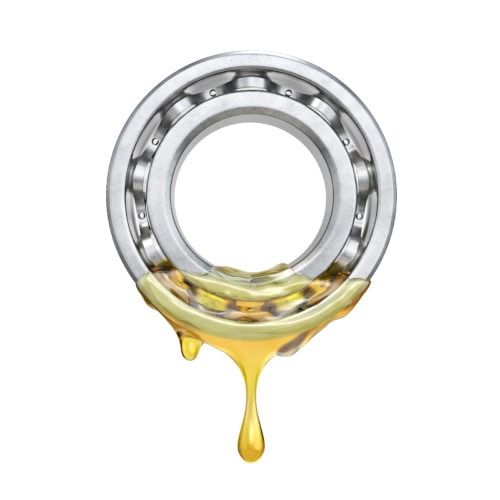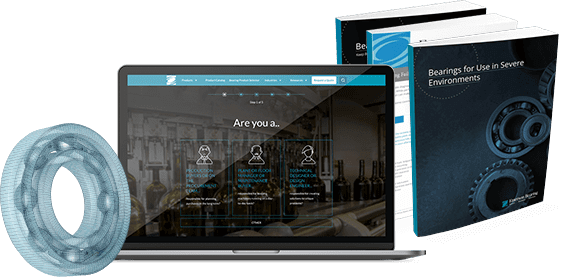Machine Tools
Machine Tool applications require bearings that are designed for rigid, high speed, high precision machine tool spindles.
Angular Contact Ball Bearings
The cages for Angular Ball Bearings can be made with two kinds of materials: phenolic or bronze. In many cases, these bearings are in a stacked pre-load. Emerson Bearing has pre-loads available in L, M, and H. They are also available in ABEC classes 5, 7, and 9. This rating affects how fast they can turn and how much axial play they have.
Machine tools are designed to cut or shape metals, ceramics, wood, and other materials into a desired form. Historical artifacts suggest machine tools have been used by humans for thousands of years. Lathes, for example, can be traced all the way back to Ancient Egypt, where they were used to create ceramic bowls, vases, plates, and other items that are still being discovered today. Early forms of machine tools were fairly straightforward in design, using plain bearings and linear guides that rely on sliding contact between surfaces.
Advancements in machine tool technology were accelerated in the 1800s when guideways and other components were enhanced to improve alignment and accuracy. The next major innovations were focused on improving speed and efficiency. The replacement of plain bearings with rolling-element bearings reduced sliding friction between moving parts, allowing spindles to rotate at significantly higher speeds and decrease the occurrence of backlash. Today, the use of lubricated slideways, ball screws, and high-precision roller bearings enables further improvements to the precision, speed and efficiency of modern machine tools.
What Are the Key Bearings and Features for Machine Tools?
Today’s machine tools rely on various specialized components that allow them to operate smoothly and efficiently while holding tight tolerances. High quality precision bearings are particularly important to the accuracy and reliability of machining equipment as they are responsible for directing and enhancing spindle movement. These components generally consist of balls or rollers that are positioned between inner and outer raceways.
A few of the most common types of bearings include:
- High precision cylindrical roller bearings.Cylindrical roller bearings use cylinders as the rolling element and are typically available in single or double row designs. These bearings are constructed to handle large radial loads and are well-suited for high speed applications that require high running accuracy of bearing-spindle arrangements.
- Ceramic hybrid spindle bearings.Ceramic hybrid spindle bearings provide increased spindle speed, improved stiffness, and enhanced resistance to high temperatures. The ceramic balls used in these bearings operate at lower temperatures, which prolongs the service life of lubricants. They also operate at lower vibration levels, resulting in increased spindle rigidity.
- Angular contact bearings.Angular contact ball bearings feature inner and outer raceways that are offset relative to one another in the axial direction, allowing them to accommodate combined radial and axial loads simultaneously. The axial load capacity of these bearings increases as the contact angle becomes larger. The contact angle refers to the angle between the line connecting the two points where the ball and raceways make contact in the radial plane.
- Ball screw support bearings.Ball screw support bearings allow for accurate positioning of workpieces or machine components. These bearings are typically available in high-rigidity and high-capacity series, and each one is designed specifically for the applications they support. Their specialized geometries allow them to handle large axial loads in two directions.
What Are the Applications of Machine Tool Bearings?
Machine tool bearings are designed with distinct geometries, features, and materials that make them suitable for specific machining purposes. Anticipated load pressure, temperature fluctuations, exposure to chemicals, and other factors will influence which type of bearing is best suited for a particular application. Ball and roller bearings are among the most versatile bearing types, and these are used in everything from turbine engines to medical equipment.
The rolling elements used by roller bearings come in a wide range of shapes, including balls, cylindrical rollers, tapered rollers, needle rollers, spherical rollers, straight rollers, and more. Mounted bearings consist of ball, roller, or sleeve bearings installed in a housing that provides additional support and environmental protection.
Specific machine tool bearing applications include:
- Machining centers
- Automatic screw machines
- Grinding machines
- High speed spindles
- Rotary tables
- Live and dead centers
- Water jet machines
How to Maintain Proper Lubrication and Maintenance?
Understanding and implementing proper bearing maintenance techniques will enhance the lifespan and performance of these critical machine tool components. To benefit from the rotational accuracy, speed, and low heat generation enabled by precision bearings, it is absolutely essential to make sure shafts and housings are properly and accurately mated with the bearing. An excessively tight fit can reduce the internal clearance of the bearing and increase the operating temperature, while a fit that is too loose can cause fretting, wear, and excess heat generation. 
In addition to a precision bearing’s specific design and construction, these three interacting factors can have a significant impact on overall bearing performance:
- Friction can cause considerable damage to machinery by creating excessive wear on the bearings.
- Temperature can have adverse effects on bearing performance if the temperature tolerance of the selected bearing is not appropriately matched with the application’s specific operating environment.
- When applied to bearing surfaces, lubricants prolong bearing life and reduce excess heat generation. By creating a protective film between rolling elements and rings, lubricants reduce wear and tear in bearings by minimizing friction between moving components. In certain cases, lubricants can also benefit the cooling system.
Bearing lubricants essentially come in two forms: oil and grease. While grease tends to be simpler to use, oil lubricants offer several distinct advantages for high temperature, high speed conditions that are often encountered in machine tool applications. The most common lubrication systems for applying oil to bearings include:
- Oil is applied to the bearing via wicking, dripping, or submerging part or all of the bearing in an oil reservoir.
- Oil is splashed onto the bearing using a high speed rotating gear or mechanical component that is partially submerged in an oil reservoir.
- Air/oil mist.An external source sprays small droplets of oil into the bearing. This oil application system is ideal for lubricating and cooling bearings in high temperature, high speed, and light load conditions.
- An external source is used to squirt oil into the bearing. This lubrication system is often preferred in applications with heavy loads, high temperatures, and high speeds.
The main types of oil lubricants used with precision bearings include:
- Petroleum oils are great general purpose oils for use in normal temperatures. Additives can be used in petroleum lubricants to inhibit oxidation.
- Diesters are synthetic oils formulated for low torque applications involving sub-zero starting temperatures.
- Silicones are synthetic oils that are capable of maintaining relatively constant viscosities across their recommended temperature ranges.
- Fluorocarbons are corrosion resistant synthetic oils that are ideal for reactive or high temperature applications.
Emerson Bearing for Your Machine Tool Bearings
As machine tools become increasingly more complex, the use of specialized high precision bearings is essential for maximizing performance, speed, accuracy, and machine uptime. Understanding the various bearing types and how each will respond to specific operating conditions will help you make the best selection for your application. To maximize the life and performance of your machine tool and its components, it is also important to properly maintain your bearings through regular inspection and lubrication.
At Emerson Bearing, we understand the high demands that are placed on machine tools to produce precision parts that meet increasingly stringent industry standards. With five decades of experience, a vast bearing inventory, and a worldwide sourcing network, we work with clients from all industries to identify high precision bearings that will accommodate each application’s unique requirements and restrictions. Our extensive bearing selection includes advanced solutions that will ensure optimal performance and durability for even the most challenging operations and environments.
To learn more about our precision bearing solutions for machine tools, please contact us today
Special Solutions: As machine centers operate at higher speeds and demand greater levels of precision we recommend the new generation of bearings made from advanced steels. These provide extended bearing life and increased tolerances. We offer several brands, such as Barden and NSK which provide this option. Other available options include Sealed bearings for harsh environments.
Contact our Marketing Specialist:
Bob Piracini – E-mail
Phone: 1.866.995.8764























